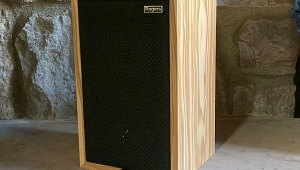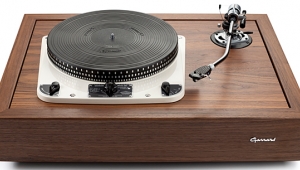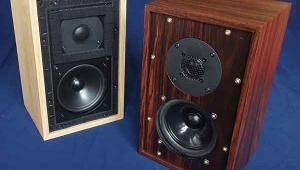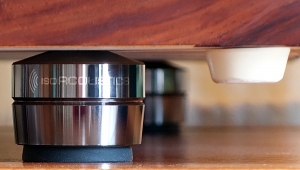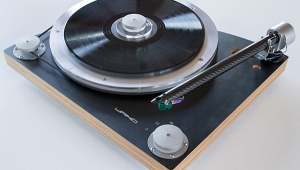| Columns Retired Columns & Blogs |
Listening #85
We murder to dissect.—William Wordsworth
Footnote 1: I'm being unfair: James Randi did in fact put me in my place, with a witheringly funny illustration of a 1960s-era cartoon character named Dudley Do-Right. I have hesitated to even think of the great man since then, in apprehension of the even more clever taunts that would surely ensue.
Tice Clock: Are there two more loaded words in all of hi-fi?
For those too young to know: In 1990, an audio manufacturer named George Tice brought to market a $350 accessory that could improve the sound of any domestic music system, simply by being connected to an AC outlet in the same room—or so he claimed. But the claim was incredible, because the product appeared to be nothing more than a rebadged RadioShack digital alarm clock to which an invisible "proprietary treatment" had been applied. Stereophile borrowed and tested various samples of the Tice Clock, and although one writer said he might have heard a very slight effect, editor John Atkinson summed up our coverage by stating that not only did the Clock fail to perform as advertised, but George Tice's technical explanations for it had no basis in scientific fact. Thomas J. Norton, Stereophile's technical editor at the time, added that the Tice Clock was identical, inside and out, to a $20 RadioShack alarm clock—to the naked eye.
An amusing side note: The Tice Clock was also one of the grains of sand around which professional skeptic James Randi oozed the pearl of his famously clever exposé of our hobby. As Randi stated on his website, "The Tate Clock . . . is only one of the items [Stereophile] tested and approved." John Atkinson and I both noted, publicly, that not only did Randi get the product's name wrong—an indication that this debunker of mind-readers thinks he can glean information from the printed page without actually having to read—but he misstated our review conclusions by a statistically significant 180°. Randi responded with as much world-weary, can-you-believe-these-fruitcakes condescension as he could muster, decrying our pettiness for even mentioning his "typo"—and, of course, ignoring completely the matter of his false report of our review conclusions. As I said: clever (footnote 1).
Field day
Back to the plot: Whenever alternative science is evoked in an attempt to explain the technological workings of an audio component or tweak—more often than not it's the latter, of course—we of the press would do well to remember l'Affaire Tice. And here's why: Even though Stereophile reported, truthfully, that the Tice Clock was inadequate to every task except reporting the time of day, there remain those who believe we committed a journalistic sin by reporting on it at all.
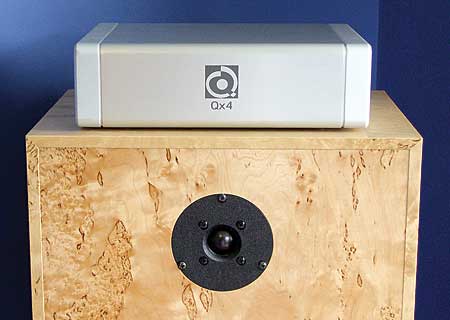
So it goes, I guess, for any of us who would report on the products of Quantum Resonant Technology, of Santa Monica, California, which I mentioned in last month's "Listening" column. The company's Qx4 audio accessory ($2399) is remarkable for two things: Its use in a good-quality system has a consistently audible effect—music recordings sound notably and consistently clearer, bigger, more open, and more (naturally) detailed—and QRT's explanation of the technological basis of that effect is unsatisfying. The former puts the Qx4 in an altogether higher, nobler plane than the Tice Clock, but the latter still bugs me.
In a nutshell, QRT describes the Qx4 as a "scalar field generator" that uses "technology derived from quantum mechanics" to provide "ordering and stabilization of magnetic field effects." The company also says the Qx4 isn't a filter of any sort, and thus does not impede current delivery in the slightest. The latter is certainly true: The Qx4 places nothing but electrical contacts and heavy-gauge wires in line with the household current. But if the task that it doesn't perform is clear, the one that it does perform remains cloaked in mystery. I won't pretend I understand quantum physics better than anyone else whose post-collegiate science education is limited to reading National Geographic at the dentist's office, but it seems to me that anyone who can design and manufacture a useful, practical, household generator of "scalar fields" would have been kidnapped by the CIA by now and put to work building superweapons, as were Enrico Fermi, Wernher von Braun, and Tony Stark. That a marginal industry such as ours can attract so many people who have successfully farted at the laws of physics never ceases to amaze me.
The skepticism with which I regard Quantum RT's official explanation (footnote 2) also comes from having looked inside one of their Qx4s. Apart from the expected power-supply components, the Qx4's single circuit board contained four discrete transistors, one voltage regulator, four very small capacitors, six resistors, one crystal, four coils, and an 18-pin chip of indeterminate function. (That chip and most of the other parts were obscured by a coating of something hard, dark, and opaque.) Not that this means anything, but I have owned and repaired wah-wah pedals of greater apparent complexity.
Having said all that: The Quantum Qx4 works. Not only does it provide one of the most clearly audible performance differences I've heard from a non-cable accessory, its effect has been documented in a series of laboratory differential tests, conducted by Acuity Products of East Sussex, England (www.acuityproducts.co.uk). I don't think it's a consumer magazine's place to publish a manufacturer's test graphics within the course of a report any more than it's our place to copy a product description, word for word, from a promotional brochure. But you can see Acuity's results for yourself on the Internet. And, yes, they appear quite remarkable.
I have on hand four samples of the Qx4, the most effective being the two that are dedicated to my pair of Audio Note AN-E speakers. (The others, when I use them at all, are adjacent to my preamp and to the AC outlet strip that powers my system.) According to Roy Gregory of Nordost Corp.—Nordost distributes Quantum products in the US—Qx4s positioned directly above or below a conventional loudspeaker control the stray electromagnetic fields given off by, and perhaps reflected back at, the motor of each dynamic driver. In light of that explanation, I couldn't help thinking of the Qx4 as an active version of the altogether passive VPI dB-5, aka the VPI Brick.
Scarcely a week has gone by when I've failed to amuse myself or others by switching those two Qx4s on and off and listening for the difference. This morning, in fact, I invited my wife to play that game. I plugged the AC cords of the two speaker-mounted Qx4s into the same switchable, heavy-duty outlet strip, then sat on the floor between the speakers, the outlet strip in my lap and my back toward the main listening seat. I played one of Janet's current fave albums—Leonard Cohen's Live in London (CD, Sony), an AIFF copy of which I've ripped to my iMac—and asked her to let me know whenever it seemed that I might have done something to change the sound overall, and to try to describe the change in her own words, as well as to tell me whether she thought it was a change for the better or for the worse.
Footnote 1: I'm being unfair: James Randi did in fact put me in my place, with a witheringly funny illustration of a 1960s-era cartoon character named Dudley Do-Right. I have hesitated to even think of the great man since then, in apprehension of the even more clever taunts that would surely ensue.
Footnote 2: "Scalar Field" sounds scientific, but all it means is that any particular property is not associated with a specific direction. Temperature, for example, is a scalar field whereas magnetic and electric fields are not, because they are directional. You can read my thoughts on the misappropriation of scientific terms here.—John Atkinson
- Log in or register to post comments


